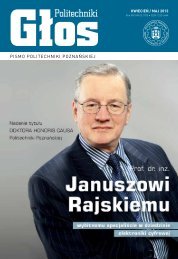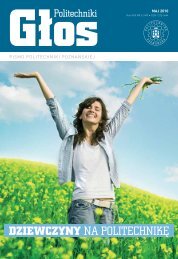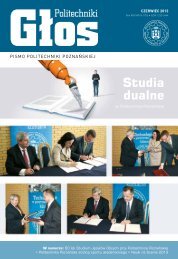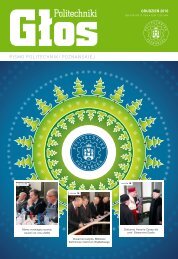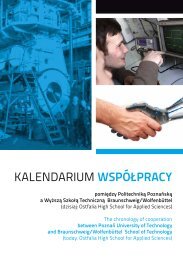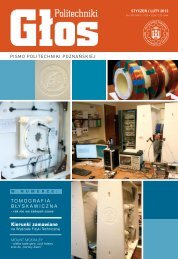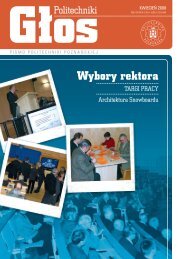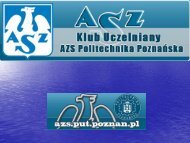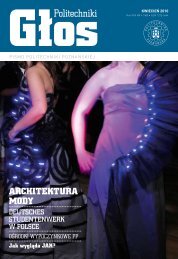2WATER PROCEEDINGS.pdf - AktualnoÅci Politechniki PoznaÅskiej
2WATER PROCEEDINGS.pdf - AktualnoÅci Politechniki PoznaÅskiej
2WATER PROCEEDINGS.pdf - AktualnoÅci Politechniki PoznaÅskiej
Create successful ePaper yourself
Turn your PDF publications into a flip-book with our unique Google optimized e-Paper software.
secondary channels, relocating the dikes or constructing bypasses. Along the Rhine and the IJssel 39 projects are identified.<br />
Each project is unique because of specific issues and because of the cooperation with local stakeholders. The projects will also<br />
improve the spatial quality of the river landscape. One of the narrowest bends in the Waal (a branch of the Rhine) is at<br />
Nijmegen. The government decided to give the Waal more room by relocating the dike 350 meters land inwards to widen the<br />
winter bed. A long peninsular in the river will be created by the excavation of the channel, directly opposite Nijmegen’s<br />
historical city center. It offers excellent opportunities for the people of Nijmegen, for recreation but maybe also for housing,<br />
hotels or museums. KuiperCompagnons was invited to propose a strategy for the development of the island. The strategy of<br />
KuiperCompagnons offers a 'new romantic' perspective. In Poznan the excavation of old meanders in the river Warta is in<br />
study. It offers opportunities for nature and recreation, but also for urban functions and the waterfront. It will help<br />
reconnecting the town with the river and at the same time guarantee the water safety.<br />
Krzysztof BOROWSKI, Roman PILCH<br />
Wydział Architektury <strong>Politechniki</strong> Poznańskiej<br />
THE WARTA RIVER BOULEVARD IN KONIN FROM A PERSPECTIVE OF THE NEW URBAN PLANNING<br />
Based on the example of the developed Warta River Boulevard in Konin, the role and significance of geo – and physiographic<br />
determinants of the waterside locations was presented as vital factors that have a formative effect on the city and culture.<br />
The importance of the promotional and investment procedure from a perspective of the New Urban Planning was emphasized.<br />
The significance of the river and the borderline between water and land was stressed in shaping of an appealing spatial and<br />
social image of Konin as well as its economic potential. Leading determinants and factors behind Konin’s development were<br />
distinguished with particular emphasis on Warta River as vast development potential for the city and the Konin’s region.<br />
The significance of Polish and European communications’ and transportation corridors’ programs was highlighted with special<br />
emphasis on sailing. A feasibility study into furnishing of a boulevard for pedestrians as an important stimulus for the Konin’s<br />
Old City was also undertaken. Stages of the developed construction of the Warta River Boulevard were detailed.<br />
BULWAR NADWARCIAŃSKI W KONINIE W UJĘCIU NOWEJ URBANISTYKI<br />
Przedstawiono rolę i znaczenie determinanty geograficzno-fizjograficznych lokacji nadbrzeżnych jako ważnego czynnika miastotwórczego<br />
i kulturotwórczego na przykładzie realizacji Bulwaru Nadwarciańskiego w Koninie. Uwypuklono znaczenie procedury<br />
promocyjno-inwestycyjnej w ujęciu Nowej Urbanistyki. Podkreślono znaczenie rzeki i przestrzeni stykowej woda - ląd w kształtowaniu<br />
atrakcyjnego wizerunku przestrzennego i społecznego Konina oraz jego zasobności gospodarczej. Scharakteryzowano<br />
uwarunkowania i czynniki przewodnie rozwoju Konina ze szczególnym podkreśleniem rzeki Warty, jako olbrzymiego potencjału<br />
rozwojowego miasta i regionu konińskiego. Uwypuklono znaczenie polskich i europejskich programów komunikacji i korytarzy<br />
transportowych z szczególnym uwzględnieniem żeglugi śródlądowej. Dokonano również analizy możliwości urządzenia bulwaru<br />
spacerowego, jako ważnego elementu aktywizacji Starówki Konina. Wyszczególniono etapy realizowanej budowy bulwaru<br />
nadwarciańskiego.<br />
Daria BRĘCZEWSKA-KULESZA<br />
Wyższa Szkoła Gospodarki w Bydgoszczy<br />
THE PERCEPTION OF SMALL RESERVOIRS AND WATERCOURSES IN THE HISTORY AND IDENTITY OF CITIES<br />
For ages water have played a significant role in shaping the identity of cities and have had a crucial impact on their<br />
development. More seldom the attention is paid to a big number of smaller reservoirs or watercourses such as ponds, claypits<br />
or brooks. Their significance was not of such importance, however, they were exploited in many ways. Brooks supplied<br />
cities with clear water, little lakes or ponds were used for fish breeding and recreational purposes. Their proper<br />
incorporation in the land use planning was an advantage of the 19 th century city districts, which ensured contact with<br />
nature to their citizens. They have also become a part of historical scenery of cities and since well-kept and cared, have<br />
been an ideal place for relax and recreation. This article presents examples of such places.<br />
PERCEPCJA NIEWIELKICH ZBIORNIKÓW I CIEKÓW WODNYCH W HISTORI I TOŻSAMOŚCI MIAST<br />
Od tysiącleci rola wody w kształtowaniu miast była ogromna i miała zasadnicze znaczenie dla ich rozwoju. Rzadko zwraca się<br />
jednak uwagę na występujące licznie w miastach małe zbiorniki i cieki wodne jak stawy, glinianki czy strumyki. Nie miały one<br />
tak spektakularnego znaczenia, jednak były wykorzystywane na wiele sposobów. Strumyki dostarczały czystej wody do<br />
miast, kanałami doprowadzano wodę do fos, niewielkie jeziorka czy stawy służyły hodowli ryb, a także celom rekreacyjnym,<br />
będąc ozdobą parków. Odpowiednio ujęte w planach zagospodarowania miast stanowiły pozytywny akcent w XIX<br />
wiecznych dzielnicach mieszkaniowych, zapewniając mieszkańcom kontakt z naturą. Wpisały się w historyczny krajobraz<br />
miast, a zadbane i wypielęgnowane do dzisiaj stanowią cenne miejsce do wypoczynku i rekreacji. Przykłady takich miejsc<br />
zostały zaprezentowane w artykule.<br />
Adam CZARNECKI, Anna LEWANDOWSKA-CZARNECKA<br />
Uniwersytet Mikołaja Kopernika w Toruniu, Instytut Ekologii i Ochrony Środowiska<br />
WATER RESOURCES IN THE LANDSCAPE OF CONTEMPORARY TOWNS: THE EXAMPLE OF THE CITY OF TORUN<br />
This paper analyzes changes in the meaning of water related to different roles in the cultural economy and providing for<br />
human needs. The attention is focused on evolution in the use of environmental resources according to technology and<br />
the development stage. Some ecological measures are applied to the process in particular stages. The paper focuses on<br />
some contemporary ways of merging in a viable way water resources through the development of recreation and tourism<br />
in the city and around. The paper discusses the problem of renaturalization of river banks and the area of flooding and<br />
higher terraces connected with revitalization of the old city. Some examples of different approaches to that are presented.



